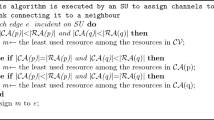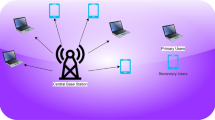Abstract
Collaborative spectrum sensing (CSS) has been suggested to overcome the destructive effect of multipath fading, shadowing, and receiver uncertainty. But, in practice, the reliability of the CSS can be severely decreased by spectrum sensing data falsification (SSDF) attacks. In an SSDF attack, some malicious users intentionally report falsified local sensing results to the data collector or fusion center and significantly degrade the CSS performance. As a countermeasure against SSDF attack, we introduce a new defense method called attack-aware CSS (ACSS). The proposed ACSS method estimates the credit value of each cognitive radio user and identifies the malicious attackers along with their attack strategies. To do this, the innovated method allocates an appropriate collaborative weight for each user and improves the CSS performance. We evaluate the performance of the ACSS by comparing it with conventional likelihood ratio test (LRT) and weighted sequential probability ratio test (WSPRT) under various number of malicious. Furthermore, the practical limitation issues that need to be considered when applying the ACSS technique are discussed. Simulation results show the effectiveness of the proposed method for defense against SSDF attacks compared with conventional LRT and WSPRT.









Similar content being viewed by others
References
Mitola, J., & Maguire, G. Q. (1999). Cognitive radio: Making software radios more personal. IEEE Personal Communications, 6(4), 13–18.
Haykin, S. (2005). Cognitive radio: Brain-empowered wireless communications. IEEE Journal of Selected Areas in Communications, 23(2), 201–220.
Akyildiz, I. F., Lee, W.-Y., Vuran, M. C., & Mohanty, S. (2006). NeXt generation/dynamic spectrum access/cognitive radio wireless networks: A survey. Computer Networks, 50(13), 2127–2159.
Mishra, S. M., Sahai, A., & Brodersen, R. W. (2006). Cooperative sensing among cognitive radios. IEEE International Conference on Communications, 2, 1658–1663.
Akyildiz, I. F., Lo, B., & Balakrishnan, R. (2011). Cooperative spectrum sensing in cognitive radio networks: A survey. Physical Communication, 4(1), 40–62.
Ganesan, G., & Li, Y. (2007). Cooperative spectrum sensing in cognitive radio, part I: Two user networks. IEEE Transactions on wireless communications, 6, 2204–2212.
Ganesan, G., & Li, Y. (2007). Cooperative spectrum sensing in cognitive radio, part II: Multiuser networks. IEEE Transactions on wireless communications, 6, 2214–2222.
Ghasemi, A., & Sousa, E. S. (2005). Collaborative spectrum sensing for opportunistic access in fading environments. In IEEE international symposium on new frontiers in dynamic spectrum access networks (DySPAN) (Vol. 2, pp. 131–136).
Ghasemi, A., & Sousa, E. S. (2007). Opportunistic spectrum access in fading channels through collaborative sensing. Journal of Communications, 2(2), 71–82.
Chen, R., Park, J.-M., Hou, Y. T., & Reed, J. H. (2008). Toward secure distributed spectrum sensing in cognitive radio networks. IEEE Communications Magazine, 46(4), 50–55.
Chen, R., Park, J.-M., & Bian, K. (2008). Robust distributed spectrum sensing in cognitive radio networks. In Proceedings of IEEE international conference on computer communications (INFOCOM) (pp. 31–35).
Rawat, A. S., Anand, P., Chen, H., & Varshney, P. K. (2011). Collaborative spectrum sensing in the presence of Byzantine attacks in cognitive radio networks. IEEE Transactions on Signal Processing, 59(2), 774–786.
Chen, R., Park, J.-M., & Bian, K. (2012). Robustness against Byzantine failures in distributed spectrum sensing. Computer Communication, 35(17), 2115–2124.
Chen, C.-Y., Chou, Y.-H., Chao, H.-C., & Lo, C.-H. (2012). Secure centralized spectrum sensing for cognitive radio networks. Wireless Networks, 18(6), 667–677.
Li, H., Cheng, X., Li, K., Hu, C., Zhang, N., & Xue, W. (2013). Robust collaborative spectrum sensing schemes for cognitive radio networks. IEEE Transactions on Parallel and Distributed Systems, 25(8), 2190–2200.
Chen, C., Song, M., & Xin, C. (2014). CoPD: A conjugate prior based detection scheme to countermeasure spectrum sensing data falsification attacks in cognitive radio networks. Wireless Networks, 20, 2521–2528.
Hyder, C. S., Grebur, B., Xiao, L., & Ellison, M. (2014). ARC: Adaptive reputation based clustering against spectrum sensing data falsification attacks. IEEE Transactions on Mobile Computing, 13(8), 1707–1719.
Ma, J., Zhao, G., & Li, Y. (2008). Soft combination and detection for cooperative spectrum sensing in cognitive radio networks. IEEE Transaction on Wireless Communications, 7(11), 4502–4507.
Sriharipriya, K. C., & Baskaran, K. (2014). Collaborative spectrum sensing of cognitive radio networks with simple and effective fusion scheme. Circuits, Systems, and Signal Processing, 33, 2851–2865.
Urkowitz, H. (1967). Energy detection of unknown deterministic signals. In Proceedings of the IEEE (pp. 523–531).
Digham, F. F., Alouini, M. S., & Simon, M. K. (2007). On the energy detection of unknown signals over fading channels. IEEE Transaction on Communications., 55(1), 21–24.
Varshney, P. K. (1996). Distributed detection and data fusion. New York: Springer.
Author information
Authors and Affiliations
Corresponding author
Rights and permissions
About this article
Cite this article
Sharifi, A.A., Niya, J.M. Securing Collaborative Spectrum Sensing Against Malicious Attackers in Cognitive Radio Networks. Wireless Pers Commun 90, 75–91 (2016). https://doi.org/10.1007/s11277-016-3331-8
Published:
Issue Date:
DOI: https://doi.org/10.1007/s11277-016-3331-8




